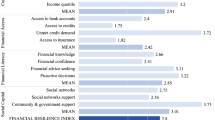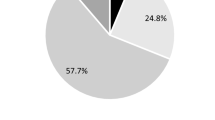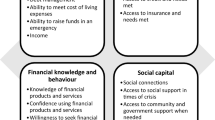
Overview
- Brings a holistic perspective that considers human agency & structural context that shapes financial vulnerability
- Draws on quantitative data and qualitative research
- Offers a framework to better understand the complex ways in which financial vulnerability emerges and can be addressed
Access this book
Tax calculation will be finalised at checkout
Other ways to access
About this book
This book examines financial vulnerability: a state in which a person or household cannot absorb any substantial spending or negative income shock without substantial financial and ultimately broader harm such as job loss, emotional harm, or mental illness. The focus of the book is on the experiences of low- income and modest income Canadian families – families which, by virtue of being in the lower income brackets, are particularly at risk of experiencing financial hardship. Looking at vulnerability from a conceptual and empirical lens, this book offers a framework to better understand the complex and interdependent ways in which financial vulnerability emerge and can be addressed. By locating its analysis of individual and household financial management in wider community, cultural, and economic contexts, this book seeks to offer holistic policy recommendations to reduce financial vulnerability, with implications that go beyond Canada and to other developed countries.
Similar content being viewed by others
Keywords
Table of contents (7 chapters)
-
Front Matter
-
Back Matter
Authors and Affiliations
About the authors
Jerry Buckland is Professor of International Development and of Economics, at respectively, Menno Simons College (University of Winnipeg affiliate) and the Redekop School of Business, Canadian Mennonite University, Canada.
Brenda Spotton Visano is a distinguished University Professor in Economics and Public Policy at York University in Canada. Her community-engaged, policy- oriented research focuses on advancing access to financial services, enabling access to higher education for non-traditional students, and analysing funding frameworks for community organizations. She is the author/co-author of many scholarly articles and community-focused reports for First Nations organizations, UNESCO and NGOs. Together with Chris Robinson and Jerry Buckland, she co- edited the 2018 book Payday Lending in Canada, published by Palgrave Macmillan.
Bibliographic Information
Book Title: Financial Vulnerability in Canada
Book Subtitle: The Embedded Experience of Households
Authors: Jerry Buckland, Brenda Spotton Visano
DOI: https://doi.org/10.1007/978-3-030-92581-9
Publisher: Palgrave Macmillan Cham
eBook Packages: Economics and Finance, Economics and Finance (R0)
Copyright Information: The Editor(s) (if applicable) and The Author(s), under exclusive license to Springer Nature Switzerland AG 2022
Hardcover ISBN: 978-3-030-92580-2Published: 03 March 2022
Softcover ISBN: 978-3-030-92583-3Published: 04 March 2023
eBook ISBN: 978-3-030-92581-9Published: 02 March 2022
Edition Number: 1
Number of Pages: XIX, 179
Number of Illustrations: 6 b/w illustrations, 3 illustrations in colour
Topics: Macroeconomics/Monetary Economics//Financial Economics, Microeconomics, Economic Policy, Social Policy, Development Finance



